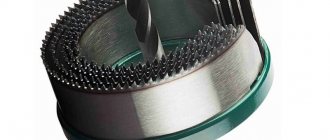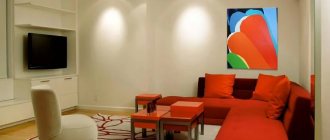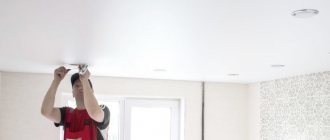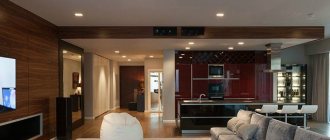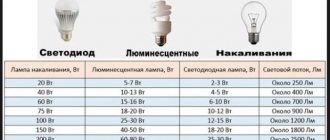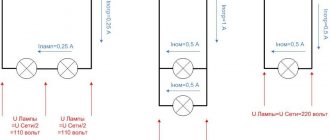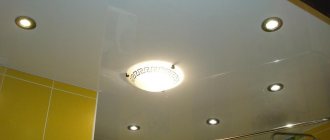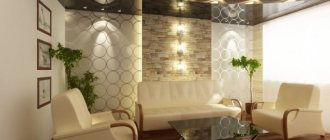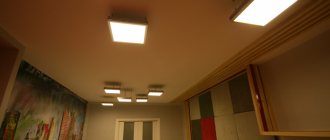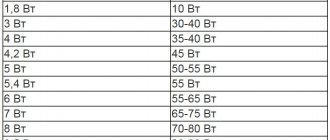Functional differences of spotlights
Spotlights have become an indispensable source of lighting. They are used practically everywhere where it is needed.
According to their functional purpose, products are divided into 3 groups:
- Devices that are installed only indoors. They differ in installation methods, adjustments, and a large selection of designs;
- Models designed for lighting buildings and architectural lighting of facades. The product body is protected from moisture, dust and temperature changes;
- Shockproof and waterproof - for rooms with excessive humidity, including for lighting swimming pools.
Having determined the installation location in advance, this is not difficult to figure out.
Types of lamps used in luminaires
Almost all known types of lamps are used in office lighting fixtures, except perhaps acetylene and the like. Short characteristics of the advantages and disadvantages of various lamps will be immediately after the list:
- Incandescent lamps;
- Fluorescent lamps;
- Halogen lamps;
- LED bulbs.
Incandescent lamp
Incandescent lamp
The Ilyich light bulb, as it was commonly called, at the dawn of Soviet power, an incandescent lamp was perhaps the most common attribute of any lighting system, starting with a specimen suspended without a shade on a wire and in a socket in a closet, and ending with huge chandeliers in a palace of culture, or in a temple. This lamp has come a long way, and although it has been squeezed out by more advanced competitors, and sometimes by the governments of some countries, it is not going to disappear for a long time.
An incandescent lamp is a bulb filled with an inert gas, with a spiral made of refractory tungsten and conductors of electricity. Under the influence of current, the spiral emits light without burning out immediately, since it burns in an oxygen-free atmosphere. In pendant lamps, at home and at work, this lamp is very common.
It is believed that such a light has fewer advantages than disadvantages, but they do exist. A conventional light bulb is relatively inexpensive, and this is always interesting from a savings point of view. It is produced in a wide power range, which means you can choose what you need. An incandescent lamp does not require particularly complex designs, and it lights up almost instantly.
The disadvantages are significant, and they contribute to the market success of other types of lamps. Only ten percent of the electricity used goes to the lighting itself, the rest goes to unnecessary heating. With a low efficiency, such a lamp also does not last long. Several hundred hours, although manufacturers promise more than a thousand. In addition, the brightness of the light is such that you should be afraid for your eyesight. True, this problem can be solved by selecting the right diffuser.
Luminescent
Fluorescent Lamp
Fluorescent lamps are gas-discharge lamps. They emit light produced by passing an electric current through mercury vapor. Such devices have many advantages that make them suitable for office lighting. The operating time of such a lamp is tens of times longer than an incandescent lamp; it can reach fifteen thousand hours. The manufacturer is able to regulate the emission spectrum, which allows the production of so-called fluorescent lamps, although it would be more accurate to call it natural. The cost of such a device is relatively low.
The disadvantages of fluorescent lamps, however, are also significant. They are chemically dangerous, as already mentioned, the working element is mercury vapor, of which there is quite a lot, up to one gram. If the lighting spectrum is not selected correctly, color distortions may occur. Moreover, the spectrum rarely remains stable for long. Not only does the lamp have a narrow power range, but it also requires special equipment to start it. The fluorescent lamp may also interfere with radio communications by causing interference.
However, fluorescent lamps are in great demand for lighting offices and other premises.
Halogen
Halogen lamp
A halogen lamp differs from an incandescent lamp by filling the bulb. It contains bromine or iodine vapor, and this is enough for the device to last several times longer, and it does not heat up very much. In terms of efficiency, it falls far short of fluorescent, but it is an effective replacement for an incandescent lamp.
LED
LED lamp
LEDs are the future of lighting systems. Almost all specialists and ordinary users are sure of this. Yes, the price is still too high, but, according to the laws of technology, it will only decrease over time, reaching at one point the optimal value. And fans of saving energy and protecting nature are already pleased with LEDs, consuming two dozen times less resources than conventional lamps. Such an advanced device is ready to work, they say, for almost seventy years; all that remains is to test it in practice. If a company is going to operate for a long time and stably, why not illuminate the office with LED lamps? Many people do this, realizing that sooner or later the investment will pay off.
LEDs have other advantages. This is resistance to changes in voltage, temperature, vibration and shock, environmental friendliness during production and disposal, and the like.
The main disadvantage of LEDs is cost, but it is not the only one. The need for a cooler, sometimes special equipment, the impossibility of working in closed structures. But this is not much, given the amazing efficiency.
Installation types
The main types differ in the installation method; this is clearly visible in the photo of spotlights.
There are four ways:
- Invoices.
- Semi-overhead.
- Built-in.
- Hanging.
In the absence of an installation niche (concrete ceiling, brick wall), or ideas such as interior design, use the overhead (external) installation method. The kit includes a mounting platform and a housing with a diffuser.
It's easy to install yourself. Before installation, holes for dowels are drilled at the point where the wires exit. A mounting bracket is screwed to the dowels, the wires are connected, and the device is attached to the bracket.
For a small niche or furniture, a semi-overlay option is used, that is, a combination of overhead and built-in fastening methods at the same time. The case, with this installation, is not all hidden in a niche; some part of it protrudes to the surface.
Built-in (mortise) devices are installed in suspended and suspended ceilings, niches, furniture elements, on the floor, as lighting for stairs, swimming pools, bars, etc. They are a solid structure with fasteners and clamps. After installation, a lamp is inserted into the fixed lampshade.
Advice! When installing a lamp, it is better to use a mount with a preload spring rather than a spacer.
Suspended - any type of base is suitable for their installation. The decorative cable is fixed to the ceiling and a lamp is connected to it. Lightweight structures do not require reinforcement.
The type of connector assumes the use of lamps of any type. Suitable for complex technical lighting and as a spotlight in the interior.
Advice! A wonderful solution for the hanging type is a spiral wire. Thanks to it, you can change the height of the lamp.
Types of lighting fixtures for the ceiling
Before you begin to properly illuminate your home, you need to know the main types of lighting fixtures that exist for installation on the ceiling. Several of the most popular types of luminaires will greatly simplify the selection or preliminary design.
Chandelier
A properly designed chandelier is a classic that will remain relevant for centuries.
Flat chandelier
Main categories of chandeliers:
- Hanging . The fastenings of a chandelier of a similar design must be reliable and durable, since the product itself may differ from other models in its heavy weight.
- Ceiling . The luminous flux of such products is directed strictly upward and helps create a weak but effective twilight.
- Classic . When installing classic central chandeliers, you should remember about the correct connection to the network of such a product. It also doesn’t hurt to strengthen the structure, which is often dominated by massive metal figures.
Even in the modern age of energy-saving lamps and LED lamps, many owners of apartments and private houses prefer to choose several beautiful pendant chandeliers.
Spotlights
The installation of suspended ceilings often involves the installation of spotlights. These lighting devices have many advantages: high luminous efficiency, minimal power consumption, compact size and long service life.
Spotlights
Based on the installation method, spotlights are divided into 3 categories: recessed, suspended or overhead. Additionally, each of the presented groups can be rotary or non-rotary. It should be clarified that the most suitable for spotlights are LED bulbs, but they are also replaced by halogen, fluorescent or simple incandescent lamps.
LED Strip Light
LED lighting is very convenient to use for installing hidden lighting or as an additional light source for stretch fabrics. LED strip is also used as decoration, for example, to create a unique luminous pattern on the ceiling.
Such installation is complicated by the need to install a special unit that regulates the switching and light power of the LED strip.
LED Strip Light
LED strips will also require the installation of a step-down transformer and a low-current electrical network. Many designers prefer neon lighting instead of LED strips.
Types of adjustment
The design system, the intensity and angle of the luminous flux, and the conditions of use divide the devices into several types of adjustment.
These include:
- Fixed (static) - a simple design does not allow changing the flow of light and illuminates only a certain area. This type is used when installing built-in, surface-mounted and semi-surface installation types;
- Rotating - frequent changes in the luminous flux accelerate the wear of the construction material, and therefore require additional reinforcement of the mounting location during installation. Used in spot and overhead models. The more reliable the design, the higher its cost will be;
- Spots - in such a system, several lampshades with a rotating mechanism are placed on a single fastener. The direction of light in them can be adjusted;
- Swivel-and-slide – allow you to create a more comfortable light zone;
- Cardan shafts - modules located in one or two rows, allow you to adjust each of them separately, in different directions;
- Track system - resembles the design of railway tracks on which lamps of the same or different types are placed. They may differ in design and power. They can be removed, added, or rotated as needed. They are all united by one electrical installation system;
- Downlights – create general and accent lighting. The luminous flux is directed downward and provides the required level of light in residential, commercial and office premises. It is used for furniture decoration, and is included in the design of street arches and canopies.
The type of adjustment and types of spotlights for residential premises are selected taking into account individual preferences, interior elements, and the degree of illumination of the room. For installation in industrial, commercial, office premises, and open areas, recommendations from specialists are required.
Which ones are better
The simpler the design of the lamp, the easier it is to maintain. More often this applies to kitchen lighting fixtures, on which, in addition to dust, grease deposits accumulate over time.
- Rounded models are better suited for suspended ceilings - during their installation and subsequent maintenance, damage to the material by sharp corners is unlikely.
- Devices with incandescent lamps project bright, familiar light, but their mounting is not very compact. Ceiling and wall frames are mounted taking into account the size of the fasteners, as a result, precious centimeters of height or space of the room are “eaten up”.
- Lamps for halogen lamps can be built into the frame at a close distance from the surface - only 4 cm is lost. Additional advantages are reduced energy consumption, brightness and durability. Lamps with a ceramic socket and glass diffuser do not create problems with overheating.
The use of spotlights in conjunction with suspended ceilings implies a limitation on the power of the installed lamps. For halogen options, the threshold values are 35–40 W. For incandescent lamps this figure should not exceed 60 W.
What to pay attention to when installing
It is necessary to study and take into account important points, without which successful installation of lighting equipment is impossible.
For example:
- For narrow rooms, it is better to arrange the system in 2 rows - this technique will visually expand the room;
- Decide which areas should be highlighted in multifunctional rooms;
- Will the lighting be main or additional;
- Where are the kitchen work and dining areas, mirrors, reading or working areas that require brighter light;
- If the housing is not compact, take into account the distance from the tension fabric to the ceiling partition. Normally no less than 8 cm;
- Built-in or surface-mounted equipment using incandescent lamps can damage the ceiling fabric. Up to 40 degrees C – permissible heating limit;
- The desired distance between light points is at least half a meter;
- The color and appearance should harmoniously complement the interior design.
In each installation case, individual nuances arise. Taking into account the features and following the instructions, you will correctly install the main lighting or supplement it.
Operating principle and design
The spotlight consists of three elements:
- a base that is attached to the surface;
- housings with clamps;
- connecting cable.
The vast majority of devices have a solid type housing.
Spotlights for incandescent lamps are structurally divided into two types:
- The open type is characterized by a U-shaped design.
- The closed type involves the use of a casing to protect the lamp from condensation; it is optimal for use in damp rooms.
Additional protection of the housing from high operating temperatures is not required. It is provided by the features of lamps built into the points. Their flasks are coated on the outside with mirror amalgam, which serves to protect the structure from overheating. The back surface of the bulb is matte, which promotes uniform distribution of light.
For correct operation of points with halogen lamps, a transformer is required. The principle is simple: the more lamps, the more powerful the transformer is needed. An induction or electronic option is suitable. During installation, the distance from the lamps to the device is taken into account - if it exceeds two meters, up to 100 W of power is lost due to resistance.
Types of lamps and sockets used
Spotlights use several types of lamps. They differ in their operating principle:
- Incandescent lamps;
- Halogen;
- Diode;
- Luminescent.
The most common sockets to use are pin sockets. Sockets GX53, GU10, G6.35, G9, G4, GU4, GU5.3 are intended for spotlights.
Lamp location and power calculation
To ensure uniform lighting of the room, the following nuances must be taken into account:
- type of lamps used and their power;
- purpose of the premises;
- illuminated area.
There are standards regarding the specific power of light flux in different rooms, which differ markedly from each other.
If incandescent lamps are used, then these standards are equal to the following values (W/sq.m):
- bedroom – 15;
- living room – 22;
- kitchen – 26;
- children's - 60;
- bathroom – 20;
- corridor – 12.
Fluorescent built-in light bulbs in the ceiling should have a power of 3-4 times less, LED - 8-12 times. When thinking through a lighting system, you should adhere to these standards. But it is advisable to install a larger number of lamps of lower power; if the norm is observed, the luminous flux will be distributed evenly, and the entire room will be illuminated to the same extent. If you install several dozen lighting fixtures, then it is advisable to distribute them into separate groups that can be turned on independently of one another.
Technical advantages
A large selection of spot lighting characteristics provides a variety of functional features. But its positive qualities, first of all, depend on the quality of the device and its configuration:
- The presence of a uniform wide angle of illumination and the ability to control it;
- Safety in high humidity;
- Protection from dust, vibration, mechanical damage;
- Low power consumption;
- Remote control, which is convenient for high ceilings;
- Increased service life;
- Possibility of using different lamps;
- No noise, flicker or glare;
- Compact and aesthetically appealing.
Each user will find other additional benefits for themselves.
Stretch ceiling lighting options
The specific location of lamps on a suspended ceiling is determined by the material from which they are made. Most often this is PVC film or fabric material. The first option is most widespread due to its strength, wear resistance and durability. However, despite the high heat resistance, incandescent light bulbs should not be placed directly next to the suspended ceiling, since due to their high temperature there is a risk of melting the material.
Features of the location of lamps on the ceiling
- The wiring is hidden under the ceiling in cable ducts, the route is placed inside the walls.
- The lighting on the ceiling should be uniform: lighting fixtures should be placed around the perimeter so that the light is distributed over the entire area of the room. Individual light bulbs must have the same power, light temperature and glow intensity.
- If the housing of the devices is hidden, then special curtain rods are installed, and a ring is fixed around the lamps to avoid tearing the film.
- The optimal light bulbs are LED. They practically do not heat up, consume little electricity and last 3-5 years, which allows you to rarely think about replacement.
Stretch ceiling without a chandelier: is it possible to get by with spot lighting?
The traditional scheme, when one chandelier hangs in the center of the room, is no longer a favorite in modern interiors. There are several reasons for choosing lighting using individual spots or spotlights. The main thing is that they allow you to create uniform, even light over the entire area of the room, without shading the corners. Other advantages include the absence of its own shadow, cost-effectiveness, high brightness of spotlights, and the ability to create interesting design solutions.
If you are still not ready to completely abandon the chandelier, you can consider the option of placing spotlights as additional lighting. For example, they are often installed above the work area in the kitchen, a coffee table in the living room, or in the passage to the loggia connected to the room.
Designers recommend choosing spotlights as the main lighting for rooms up to 30 square meters. m. Calculation of the required number of points depends on the type and power of the devices. A simplified scheme looks like this: for every 1 sq.m. The room requires a light bulb power of 20 W. This calculation is true for incandescent lamps: if you take LED lamps, the value will be much less. You can roughly compare the required number of light bulbs using the following scheme:
Disadvantages of spotlights
In some cases, a number of negative qualities can be found. You may not like:
- Complexity of system design;
- Difficulties with installing and replacing transformers;
- Changing the design of the wall or ceiling surface for built-in models with a large number of devices;
- Overheating, when using the “wrong” lamps, can ruin the appearance of the coating;
- A large number of devices require more time to care for them.
Subject to the installation conditions, taking into account various little things, disadvantages can be minimized.
Caring for spotlights
With proper care, the service life of the devices increases. Here are some tips:
- Use electrical devices only for their intended purpose;
- Clean once a year without using aerosols;
- Periodically check the condition of the wiring;
- Do not place it near fire, and install it away from water.
Compliance with safety precautions is required both when installing spotlights and during their regular maintenance.
Hole diameter
As practice shows, the common diameter of the hole for a spotlight ranges from 60 mm to 75 mm. This size should not be confused with the outer diameter of the product. For example, if the width of the lamp is 90 mm, then the diameter of the insert will be smaller - 60 mm. Therefore, the hole must be made with a size of 59-60 mm.
The width of 90 mm is the size of the external cover of the lamp. This is a decorative detail that hides the resulting gap between the hole made (60 mm) and the lamp.
Depending on the style of the room, lamps are produced with different shapes of the cover: round, square, rectangular. When choosing spotlights, their number is taken into account. And the number of holes made in drywall and other surfaces depends on this.
If the lamps are installed in the ceiling, then the distance between the rows should be approximately 1 m, and between the lamps in these rows - 1.5 m. At least 0.6 m should be retreated from the wall.
Before inserting the lamp, it is necessary to take accurate measurements of the hole, regardless of the fact that they are already indicated on the packaging. Due to this, possible errors during installation can be avoided.
What do security numbers mean?
Standard models provide a regulated protection indicator - it is indicated by the abbreviation IP. The two numbers next to it indicate:
- The first is to protect against clogging of the structure with solid particles. 0 – no protection. From 1 to 4 – possible ingress of particles (in descending order of their size). 5 – the structure is completely protected from the penetration of dust grains;
- The second is the degree of protection against moisture. From 0 to 8, where 0 means there is no protection from moisture, and 8 means it can withstand prolonged immersion in water.
Manufacturers of spotlights
Russian manufacturers – Ambrella Light, Donolux, Elektroatandart. The products meet a high level of quality and are designed for a wide price range.
Foreign companies specializing in the production of lighting systems include: ARTE LAMP (Italy), EGLO (Austria), Lightstar, LUSSOLE (Italy), Massive (Belgium), Novotech (Hungary).
Advice! When choosing a manufacturer, do not chase low cost. Good quality doesn't come cheap.
Compact and miniature assistants help not only to transform the interior. Their benefits cannot be overestimated, because the state of our vision, mood, and therefore health in general directly depends on proper lighting.
